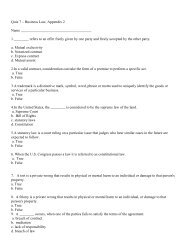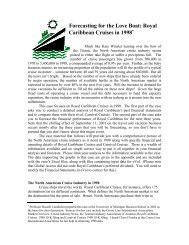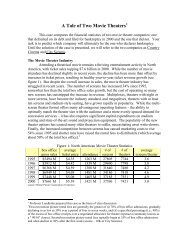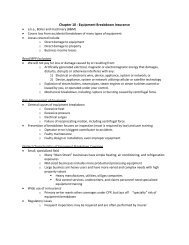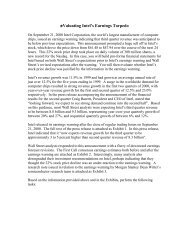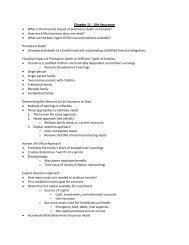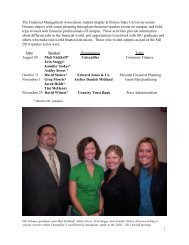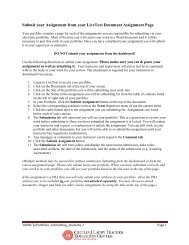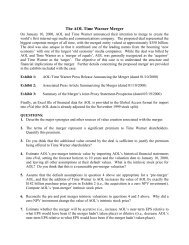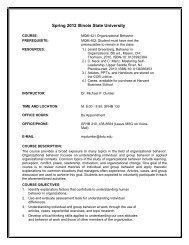Evaluating a Firm's External Environment - Illinois State University
Evaluating a Firm's External Environment - Illinois State University
Evaluating a Firm's External Environment - Illinois State University
Create successful ePaper yourself
Turn your PDF publications into a flip-book with our unique Google optimized e-Paper software.
M02_BARN4586_03_SE_C02.qxd 7/1/09 7:34 AM Page 55<br />
Chapter 2: <strong>Evaluating</strong> a Firm’s <strong>External</strong> <strong>Environment</strong> 55<br />
It began with a 5,000-word e-mail sent<br />
by Steve Balmer, CEO of Microsoft, to<br />
all 57,000 employees. Whereas previous<br />
e-mails from Microsoft founder<br />
Bill Gates—including one in 1995 calling<br />
on the firm to learn how to “ride<br />
the wave of the Internet”—inspired<br />
the firm to move on to conquer more<br />
technological challenges, Balmer’s<br />
e-mail focused on Microsoft’s current<br />
state and called on the firm to become<br />
more focused and efficient. Balmer also<br />
announced that Microsoft would cut its<br />
costs by $1 billion during the next fiscal<br />
year. One observer described it as the<br />
kind of e-mail you would expect to<br />
read at Procter & Gamble, not at<br />
Microsoft.<br />
Then the other shoe dropped. In<br />
a surprise move, Balmer announced<br />
that Microsoft would distribute a large<br />
portion of its $56 billion cash reserve in<br />
the form of a special dividend to stockholders.<br />
In what is believed to be the<br />
largest such cash dispersion ever,<br />
Microsoft distributed $32 billion to its<br />
stockholders and used an additional<br />
$30 billion to buy back stock. Bill Gates<br />
received a $3.2 billion cash dividend.<br />
These changes meant that Microsoft’s<br />
capital structure was more similar to,<br />
say, Procter & Gamble’s than to an<br />
entrepreneurial, high-flying software<br />
company.<br />
What happened at Microsoft?<br />
Did Microsoft’s management conclude<br />
that the PC software industry<br />
was no longer emerging, but had<br />
matured to the point that Microsoft<br />
Strategy in the Emerging Enterprise<br />
Microsoft Grows Up<br />
would have to alter some of its traditional<br />
strategies? Most observers<br />
believe that Balmer’s e-mail, and the<br />
decision to reduce its cash reserves,<br />
signaled that Microsoft had come to<br />
this conclusion. In fact, although most<br />
of Microsoft’s core businesses—its<br />
Windows operating systems, its PC<br />
applications software, and its server<br />
software—are still growing at the<br />
rate of about $3 billion a year, if they<br />
were growing at historical rates these<br />
businesses would be generating<br />
$7 billion in new revenues each year.<br />
Moreover, Microsoft’s new businesses—<br />
video games, Internet services, business<br />
software, and software for phones<br />
and handheld computers—are<br />
adding less than $1 billion in new revenues<br />
each year. That is, growth in<br />
Microsoft’s new businesses is not offsetting<br />
slower growth in its traditional<br />
businesses.<br />
Other indicators of the growing<br />
maturity of the PC software industry,<br />
and Microsoft’s strategic changes, also<br />
exist. For example, during 2003 and<br />
2004, Microsoft resolved most of the<br />
outstanding antitrust litigation it was<br />
facing, abandoned its employee stock<br />
option plan in favor of a stock-based<br />
compensation scheme popular with<br />
slower-growth firms, improved its systems<br />
for receiving and acting on feedback<br />
from customers, and improved<br />
the quality of its relationships with<br />
some of its major rivals, including Sun<br />
Microsystems, Inc. These are all the<br />
actions of a firm that recognizes that<br />
the rapid growth opportunities that<br />
existed in the software industry when<br />
Microsoft was a new company do not<br />
exist anymore.<br />
At this point, Microsoft has to<br />
choose whether it is going to jump-start<br />
its growth through a series of large<br />
acquisitions or accept the lower growth<br />
rates in its core markets. As described in<br />
the opening case for Chapter 10, it made<br />
a significant, but ultimately unsuccessful,<br />
effort to acquire Yahoo in an attempt<br />
to jump-start its growth in online services,<br />
a strong indicator that Microsoft,<br />
while acknowledging slower growth in<br />
its core, has not completely abandoned<br />
the idea of growing quickly in some<br />
parts of its business.<br />
Sources: J. Greene (2004). “Microsoft’s midlife crisis.”<br />
BusinessWeek, April 19, 2004, pp. 88 +; R. Guth<br />
and S. Thurm (2004). “Microsoft to dole out its cash<br />
hoard.” The Wall Street Journal, Wednesday, July 21,<br />
2004, pp. A1 +; S. Hamm (2004). “Microsoft’s worst<br />
enemy: Success.” BusinessWeek, July 19, 2004, p. 33;<br />
www.microsoft.com/billgates/speeches/2006/00-<br />
15transition.asp.<br />
This emphasis on service has become very important in a wide variety of<br />
industries. For example, in the convenience food industry, one of the major reasons<br />
for slower growth in the fast-food segment has been growth in the so-called<br />
“casual dining” segment. This segment includes restaurants such as Chili’s and<br />
Applebee’s. The food sold at fast-food restaurants and casual dining restaurants



